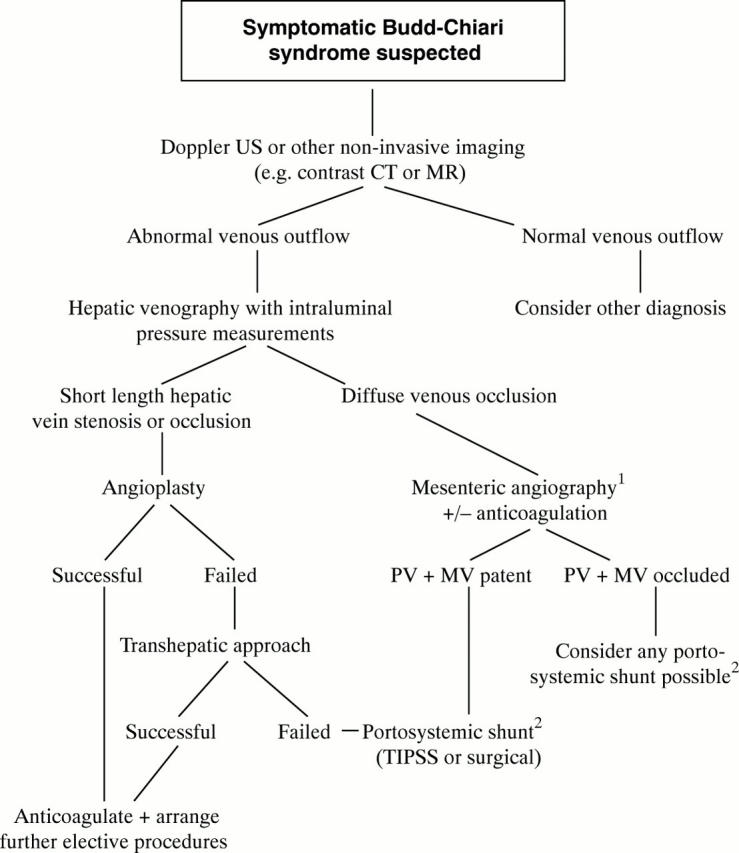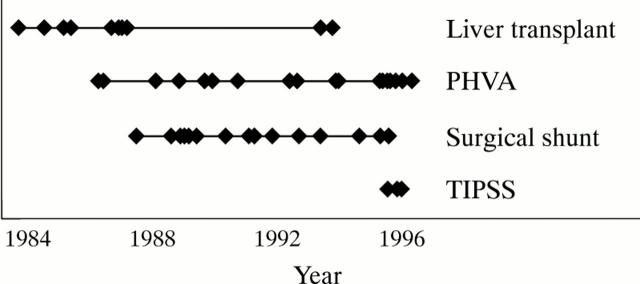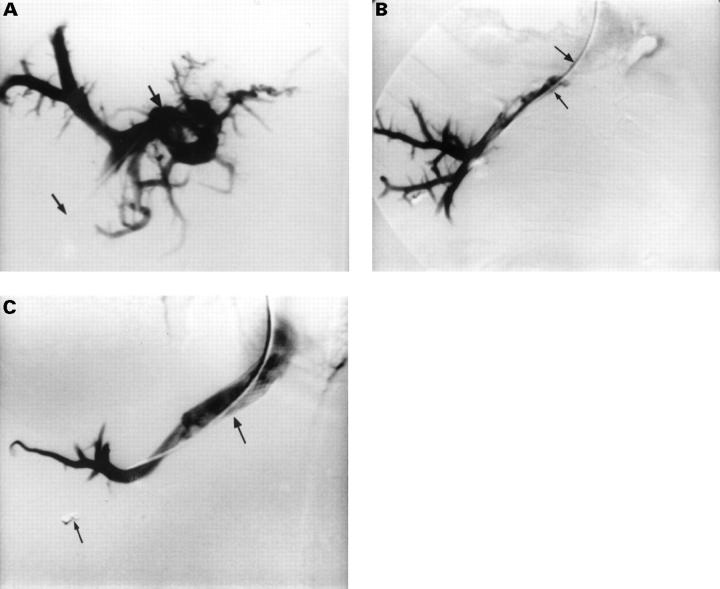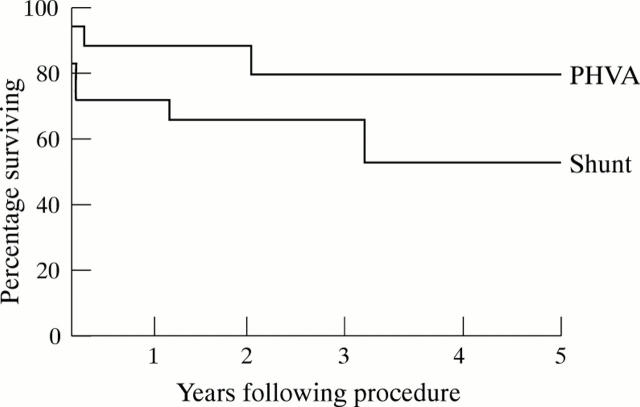Abstract
BACKGROUND—The role of percutaneous hepatic vein angioplasty in the management of Budd-Chiari syndrome has not been well defined. Over a 10 year period at our unit, we have often used this technique in cases of short length hepatic vein stenosis or occlusion, reserving surgical mesocaval shunting for cases of diffuse hepatic vein occlusion or failed angioplasty. AIMS—To review the outcome of angioplasty and surgical shunting to define their respective roles. PATIENTS—All patients treated by angioplasty or surgical shunting for non-malignant hepatic vein obstruction over a ten year period from 1987 to 1996. METHODS—A case note review of pretreatment features and clinical outcome. RESULTS—Angioplasty was attempted in 21 patients with patent hepatic vein branches and was succesful in 18; in three patients treatment was unsuccessful and these patients had surgical shunts. Fifteen patients were treated by surgical shunting only. Mortality according to definitive treatment was 3/18 following angioplasty and 8/18 following surgery; in most cases this reflected high risk status prior to treatment. Venous or shunt reocclusion rates were similar for both groups and were associated with subtherapeutic warfarin in half of these cases. Most surviving patients in both groups are asymptomatic although one surgical patient has chronic hepatic encephalopathy. CONCLUSION—With appropriate case selection, many patients with Budd-Chiari syndrome caused by short length hepatic vein stenosis or occlusion may be managed successfully by angioplasty alone. Medium term outcome is good following this procedure provided that anticoagulation is maintained. Further follow up is required to assess for definitive benefits but we suggest that this should be included as a valid initial approach in the algorithm for management of Budd-Chiari syndrome.
Keywords: Budd-Chiari syndrome; short length hepatic vein stenosis; hepatic vein occlusion; percutaneous hepatic vein angioplasty; mesocaval shunt
Full Text
The Full Text of this article is available as a PDF (142.3 KB).
Figure 1 .
Definitive procedures for BCS at Queen Elizabeth Hospital Liver Unit, 1984-1996.
Figure 2 .

Schematic illustration of combined transjugular/transhepatic balloon angioplasty procedure. (A) Hepatic vein occlusion. O = occlusion, HV = hepatic vein, IVC = inferior vena cava, RA = right atrium, RL = right lung. (B) 5F or 6F sheath introduced into HV under ultrasound guidance. (C) Guidewire introduced into IVC by manipulation or by puncture. (D) Transjugular snare wire used to capture guidewire from above. (E) Guidewire pulled proximally out of jugular vein. (F) Balloon catheter introduced from above and angioplasty carried out.
Figure 3 .
Angiograms obtained in a 37 year old man undergoing combined transjugular/transhepatic balloon angioplasty with subsequent stent insertion. (A) Percutaneous transhepatic angiogram at the time of the first procedure (thick arrow, area of occlusion; thin arrow, transhepatic catheter). (B) Image obtained after balloon angioplasty, with some improvement in venous drainage (thick arrow, transjugular catheter; thin arrow, irregular hepatic venous lumen). (C) Image obtained after stent insertion, showing further improvement in venous drainage (thick arrow, stent; thin arrow, metal coil inserted in liver along track of percutaneous sheath).
Figure 5 .
Actuarial survival curves following PHVA or surgical shunting for BCS.
Figure 6 .

Suggested algorithm for management of BCS. 1Contrast CT or MR may obviate need for direct angiography. 2Liver transplantation may be appropriate for fulminant or end stage disease.
Selected References
These references are in PubMed. This may not be the complete list of references from this article.
- Bismuth H., Sherlock D. J. Portasystemic shunting versus liver transplantation for the Budd-Chiari syndrome. Ann Surg. 1991 Nov;214(5):581–589. doi: 10.1097/00000658-199111000-00008. [DOI] [PMC free article] [PubMed] [Google Scholar]
- Griffith J. F., Mahmoud A. E., Cooper S., Elias E., West R. J., Olliff S. P. Radiological intervention in Budd-Chiari syndrome: techniques and outcome in 18 patients. Clin Radiol. 1996 Nov;51(11):775–784. doi: 10.1016/s0009-9260(96)80005-5. [DOI] [PubMed] [Google Scholar]
- Halff G., Todo S., Tzakis A. G., Gordon R. D., Starzl T. E. Liver transplantation for the Budd-Chiari syndrome. Ann Surg. 1990 Jan;211(1):43–49. doi: 10.1097/00000658-199001000-00007. [DOI] [PMC free article] [PubMed] [Google Scholar]
- Hemming A. W., Langer B., Greig P., Taylor B. R., Adams R., Heathcote E. J. Treatment of Budd-Chiari syndrome with portosystemic shunt or liver transplantation. Am J Surg. 1996 Jan;171(1):176–181. doi: 10.1016/S0002-9610(99)80095-6. [DOI] [PubMed] [Google Scholar]
- Klein A. S., Sitzmann J. V., Coleman J., Herlong F. H., Cameron J. L. Current management of the Budd-Chiari syndrome. Ann Surg. 1990 Aug;212(2):144–149. doi: 10.1097/00000658-199008000-00005. [DOI] [PMC free article] [PubMed] [Google Scholar]
- Kohli V., Pande G. K., Dev V., Reddy K. S., Kaul U., Nundy S. Management of hepatic venous outflow obstruction. Lancet. 1993 Sep 18;342(8873):718–722. doi: 10.1016/0140-6736(93)91712-u. [DOI] [PubMed] [Google Scholar]
- Mahmoud A. E., Helmy A. S., Billingham L., Elias E. Poor prognosis and limited therapeutic options in patients with Budd-Chiari syndrome and portal venous system thrombosis. Eur J Gastroenterol Hepatol. 1997 May;9(5):485–489. doi: 10.1097/00042737-199705000-00014. [DOI] [PubMed] [Google Scholar]
- Mahmoud A. E., Mendoza A., Meshikhes A. N., Olliff S., West R., Neuberger J., Buckels J., Wilde J., Elias E. Clinical spectrum, investigations and treatment of Budd-Chiari syndrome. QJM. 1996 Jan;89(1):37–43. doi: 10.1093/oxfordjournals.qjmed.a030135. [DOI] [PubMed] [Google Scholar]
- Martin L. G., Henderson J. M., Millikan W. J., Jr, Casarella W. J., Kaufman S. L. Angioplasty for long-term treatment of patients with Budd-Chiari syndrome. AJR Am J Roentgenol. 1990 May;154(5):1007–1010. doi: 10.2214/ajr.154.5.2138842. [DOI] [PubMed] [Google Scholar]
- Meier W. L., 3rd, Waller R. M., 3rd, Sones P. J., Jr Budd-Chiari web treated by percutaneous transluminal angioplasty. AJR Am J Roentgenol. 1981 Dec;137(6):1257–1258. doi: 10.2214/ajr.137.6.1257. [DOI] [PubMed] [Google Scholar]
- Millener P., Grant E. G., Rose S., Duerinckx A., Schiller V. L., Tessler F. N., Perrella R. R., Ragavendra N. Color Doppler imaging findings in patients with Budd-Chiari syndrome: correlation with venographic findings. AJR Am J Roentgenol. 1993 Aug;161(2):307–312. doi: 10.2214/ajr.161.2.8333368. [DOI] [PubMed] [Google Scholar]
- Nishikawa M., Seki K., Miyoshi S., Minami Y., Imai Y., Kawata S., Tarui S., Nakamura H. Treatment of the Budd-Chiari syndrome in polycythemia vera by repeated percutaneous transluminal angioplasty of a hepatic vein stenosis. Postgrad Med J. 1982 Aug;58(682):511–514. doi: 10.1136/pgmj.58.682.511. [DOI] [PMC free article] [PubMed] [Google Scholar]
- Ochs A., Sellinger M., Haag K., Nöldge G., Herbst E. W., Walter E., Gerok W., Rössle M. Transjugular intrahepatic portosystemic stent-shunt (TIPS) in the treatment of Budd-Chiari syndrome. J Hepatol. 1993 Jun;18(2):217–225. doi: 10.1016/s0168-8278(05)80249-1. [DOI] [PubMed] [Google Scholar]
- Orloff M. J., Johansen K. H. Treatment of Budd-Chiari syndrome by side-to-side portacaval shunt: experimental and clinical results. Ann Surg. 1978 Oct;188(4):494–512. doi: 10.1097/00000658-197810000-00007. [DOI] [PMC free article] [PubMed] [Google Scholar]
- Panis Y., Belghiti J., Valla D., Benhamou J. P., Fékété F. Portosystemic shunt in Budd-Chiari syndrome: long-term survival and factors affecting shunt patency in 25 patients in Western countries. Surgery. 1994 Mar;115(3):276–281. [PubMed] [Google Scholar]
- Pezzuoli G., Spina G. P., Opocher E., Galeotti F., Zannini P. Portacaval shunt in the treatment of primary Budd-Chiari syndrome. Surgery. 1985 Aug;98(2):319–323. [PubMed] [Google Scholar]
- Sparano J., Chang J., Trasi S., Bonanno C. Treatment of the Budd-Chiari syndrome with percutaneous transluminal angioplasty. Case report and review of the literature. Am J Med. 1987 Apr;82(4):821–828. doi: 10.1016/0002-9343(87)90022-2. [DOI] [PubMed] [Google Scholar]
- Tilanus H. W. Budd-Chiari syndrome. Br J Surg. 1995 Aug;82(8):1023–1030. doi: 10.1002/bjs.1800820807. [DOI] [PubMed] [Google Scholar]
- Valla D., Hadengue A., el Younsi M., Azar N., Zeitoun G., Boudet M. J., Molas G., Belghiti J., Erlinger S., Hay J. M. Hepatic venous outflow block caused by short-length hepatic vein stenoses. Hepatology. 1997 Apr;25(4):814–819. doi: 10.1002/hep.510250405. [DOI] [PubMed] [Google Scholar]
- Vickers C. R., West R. J., Hubscher S. G., Elias E. Hepatic vein webs and resistant ascites. Diagnosis, management and implications. J Hepatol. 1989 May;8(3):287–293. doi: 10.1016/0168-8278(89)90025-1. [DOI] [PubMed] [Google Scholar]
- Yang X. L., Cheng T. O., Chen C. R. Successful treatment by percutaneous balloon angioplasty of Budd-Chiari syndrome caused by membranous obstruction of inferior vena cava: 8-year follow-up study. J Am Coll Cardiol. 1996 Dec;28(7):1720–1724. doi: 10.1016/S0735-1097(96)00385-3. [DOI] [PubMed] [Google Scholar]
- de Sousa J. M., Portmann B., Williams R. Nodular regenerative hyperplasia of the liver and the Budd-Chiari syndrome. Case report, review of the literature and reappraisal of pathogenesis. J Hepatol. 1991 Jan;12(1):28–35. doi: 10.1016/0168-8278(91)90904-p. [DOI] [PubMed] [Google Scholar]





